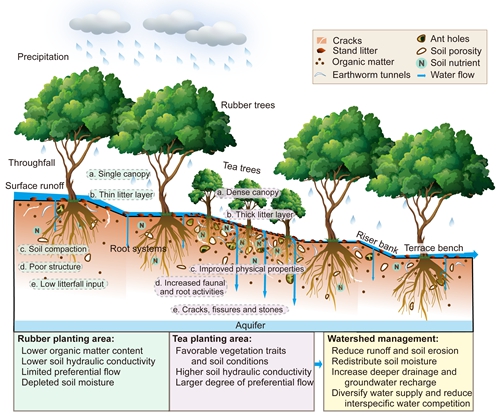Rubber-based agroforestry continues to be a promising land-use practice in Xishuangbanna. However, only few studies have investigated the effects of intercropping on the saturated hydraulic conductivity (Ks), a key soil hydraulic parameter, in the rubber-based agroforestry systems.
Researchers from Xishuangbanna Tropical Botanical Garden (XTBG) conducted a study to determine the hydrological functions of rubber agroforestry systems and the role of intercropped species.
They selected a rubber-tea agroecosystem and investigated the variation of soil infiltrability and water flow behavior.
They found that intercropping tea trees with rubber trees positively impacted soil hydraulic properties, with higher infiltrability and preferential flow being in soils underneath tea trees.
Long-term tea growth (22 years) significantly improved soil physico-chemical properties. Coupled with increased root and faunal activities, and other inhomogeneous structures (e.g., cracks and stones), the improvements in the tea planting zone substantially enhanced the infiltration capacity and preferential flow.
The measured hydraulic conductivity showed significant spatial heterogeneity and decreased with the distance from the trunks of tea trees.
The saturated hydraulic conductivity between rubber trees on the terrace benches was lower than that on the riser banks between rubber rows.
They further found that the improved infiltrability beneath tea trees reduced surface runoff and erosion risk.
“The positive and negative effects of intercropped species on hydrological ecosystem services should be tested extensively in other rubber-based agroforestry systems (e.g., rubber with coffee and cocoa) in the future”, said Prof. LIU Wenjie, principal investigator of the study.
The study entitled “Can intercrops improve soil water infiltrability and preferential flow in rubber-based agroforestry system?” has been published in Soil and Tillage Research.
Contact
LIU Wenjie Ph.D Principal Investigator
Key Laboratory of Tropical Forest Ecology, Xishuangbanna Tropical Botanical Garden, Chinese Academy of Sciences, Mengla, Yunnan 666303, China
E-mail: lwj@xtbg.org.cn
Infiltration patterns for vertical soil sections in rubber-tree agroforestry system.
(Images by ZHU Xiai)

